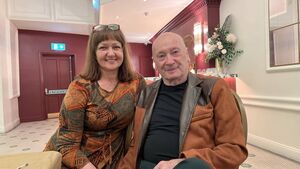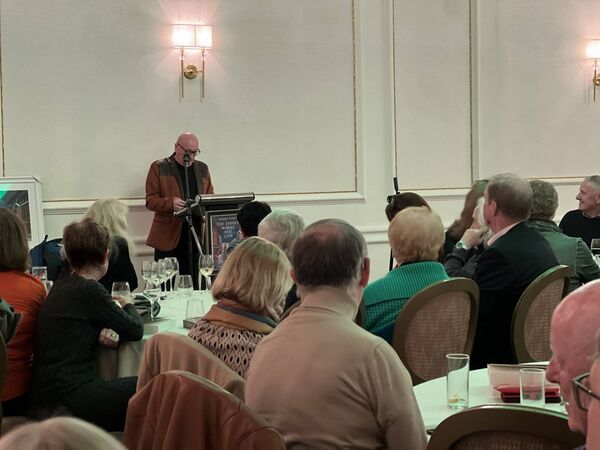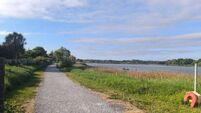Historian and showband legend Dermot Power launches epic book on Waterford's streets

Power pictured with his partner Rima Norvydiene.
Three decades in the making, 459 pages and a bibliography spanning over 300 entries. When Waterford historian Dermot Power describes his newest book “The Street Where You Live” as a labour of love, it’s a generous understatement.
“The Street Where You Live” unearths the linguistic origins, colloquialisms, and hidden meanings that have given birth to the naming of the ground beneath Waterford residents’ feet.
The genesis of the book began in 1992, when Power released his first piece of work, a 20-page booklet of the same name. Originally confined to the streets of Waterford City, his newest iteration encompasses “The Liberties” and urban sprawl of Waterford.

“This book is lots of sleepless nights, very little help, except from friends,” Power said while speaking at the book's launch on Thursday, November 13, in front of a packed-out ballroom at the Granville Hotel.
“If everything I collected I had written down…the present book would have easily been seven or eight hundred pages.”
The book covers the streets of Waterford in forensic detail - a singular passage on Dunmore Road spans six pages, charting the road’s transformation from a well-renowned locale used to burn women at the stake in the 1700s, to its present status as the pinnacle of affluent suburbia.
Giving the book life proved demoralising for Power. He bemoaned the lack of support from local heritage funds and said he was liable to cut a frustrated figure, often slumped out on a couch, rotting in front of the flat screen.
He credits his partner Rima Norvydiene as the book’s catalyst. At his nadir, she offered him a small biscuit box with €500 parcelled inside.
Her instructions were clear: Get off the couch, and start working.
From there Power searched for alternative funding, courting the same people he interviewed as a historian.
Jim Doherty of Doherty’s fish shop, The Granville Hotel’s Anne Cusack, and Joan Johnson of the Waterford Quakers were some of many names that contributed to the book’s funding.
The book was ultimately published by Kazoo Independent Publishing Services in Dublin.
Manically cross-referencing through a towering mountain of books, newspaper archives and interview records, Power says he gained an untapped insight into the quaint thought process that informed the naming of locales.
“Lots of names were generational, an example of that was Denny's lane. The real name was Penrose Lane…I knew it as Denny's lane.”
He points to the example of a now-closed Aldi on the Glen - “years ago that probably would have become known as Aldi’s lane.”
“There was another place, where Sanofi is built, out on the old Kilmeaden road. There's a very old name there…It hasn't been probably used for 400 years, called ‘Crainn na Spioróga”, ‘The Trees of the Sparrowhawks’.
“I've gotten to the stage there now that I can visualise a fella, an ancient Irish fella, walking along there, and he's captivated by these sparrowhawks flying in and out of that tree.
“And he puts the name on it… and then it becomes a name for the area, ‘The Trees of the Sparrowhawks.’ “That's the way the Irish did it...Waterford is recognised as a Viking city, which it is, but I don't think we should be defined as it because we're here 10,000 years.”
Speaking at the launch, Waterford City and County Council Mayor Seamus Ryan thanked Power for his historical contributions to the Déise.
“What sets his work apart is his gift for storytelling, and we saw that in his music as well (Power is also a well-known member of the band Simon). The ability to take historical detail and turn it into something engaging and accessible, not just for scholars or historians, but for anyone who loves Waterford,” Mayor Ryan said.
“Dermot’s discovery that the Irish Tricolour was first flown here in Waterford in 1848 stands as one of his most significant contributions, a finding that deepened our understanding of Ireland's national story and placed Waterford firmly at the heart of it.”
Having spent a career grounding himself in the streets of Waterford, writing three other historic works on Waterford, Power says just like street names, the city has moved, changed forms, and not always for the better: “What I've seen is the heart of the city gone, and replaced by phone shops, vape shops, cafés, coffee shops and beggars… this is the changing face of the city."






